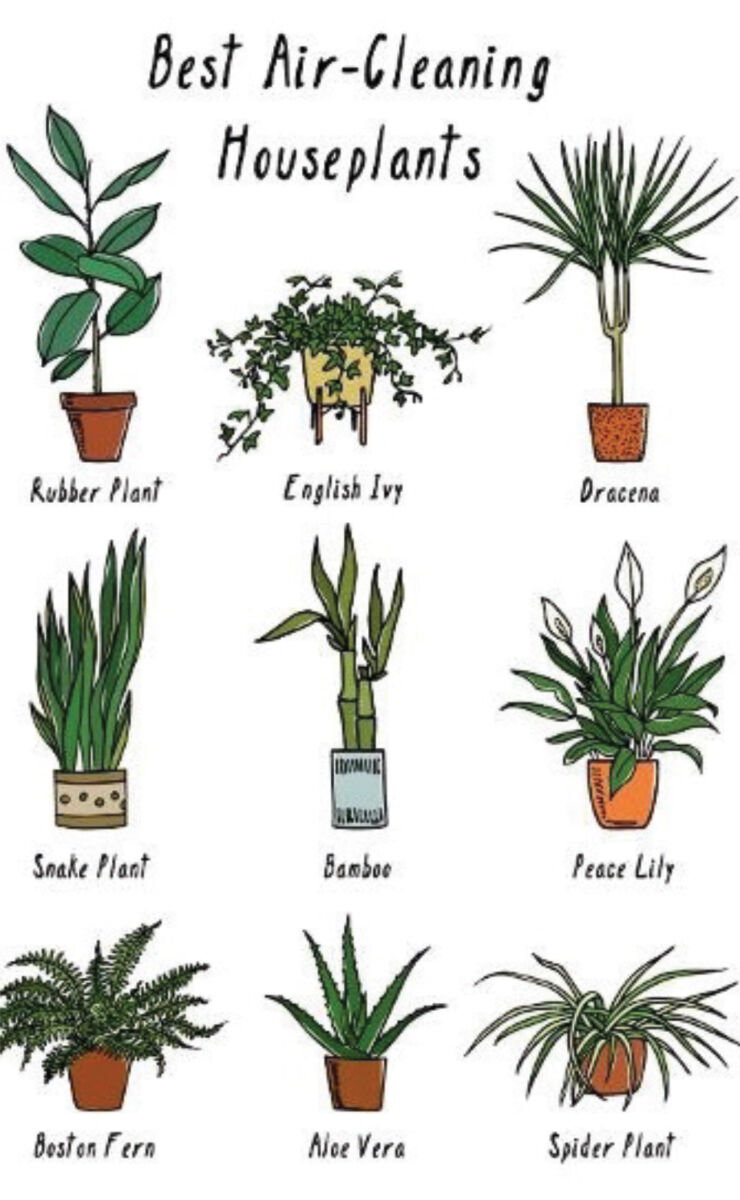Houseplants: Nature’s Air Purifiers

[Supplied]
Most of us have seen a magazine photo or walked into a home that featured the display of beautiful, thriving houseplants. These plants have become increasingly popular lately because they liven up our indoor spaces, have positive psychological effects—such as reducing stress—and are fun to grow. But did you know that houseplants are also nature’s air purifiers?
Air quality is affected by pollutants, and houseplants reduce this pollution in our homes by absorbing organic compounds like formaldehyde, trichloroethylene, carbon dioxide, carbon monoxide, volatile organic compounds and many others. These pollutants are absorbed by the plant, without harming it, instead of entering our bodies. Through the process of photosynthesis, plants convert the carbon dioxide we exhale and remove gases from the air through a process called absorption. The EPA reports that Americans spend 90% of their time indoors where pollutants can be five times higher than the outside air. Therefore, it’s essential that the air we breathe be as healthy as possible.
In 1989, NASA produced the Clean Air Study that claimed some household plants could “provide a promising economical solution to indoor air pollution.” NASA investigated the effects of plants to reduce airborne pathogens and to increase humidity in small spaces. The study found that bacterial counts correlated with increased chemical removal. Another finding determined when the same plants were consistently exposed to chemicals, such as benzene, their capacity to clean the air increased over time.
The NASA study determined that these houseplants were among the best at reducing pollutants in the home:
Aloe Vera—a succulent and healing balm for burns, it also purifies the air from formaldehyde found in varnishes and detergents.
Dracaena—easy care, colorful, strap-like foliage that needs moist but not soggy soil.
Areca Palm—graceful leaves and good for removing carbon dioxide and other chemicals.
Snake Plant—stiff, upright, sword-like leaves that likes moist areas such as bathrooms.
Bamboo Plant—attractive, popular plant that is a Chinese symbol of good fortune and prosperity. Likes slightly damp soil but not overwatering.
Rubber Plant—good for reducing pollens that cause allergies. It benefits from dry soil and bright, indirect light and thrives on neglect.
Peace Lily—a beautiful, blooming statement plant that grows in dim light.
Spider Plant—an air plant that grows quickly and needs little care. This plant is easy to propagate.
Boston Fern—a beautiful popular plant with long, feather-like branches that likes moist but not soggy soil.
ZZ plant—features striking color on new growth and is a no-fail, low maintenance plant that only requires watering monthly.
English Ivy—a low maintenance, beautiful, versatile plant with a variety and range of hues with fascinating shapes.
Now that you’ve chosen your favorite houseplants to improve the air quality in your home, how do you keep them alive? If you have a “black thumb”, how can you turn your graveyard of houseplants into thriving beautiful specimens?
“There’s no such thing as green thumb or black thumb, it’s more about how much you pay attention to your plants,” says Christopher Satch, plant scientist and instructor at the New York Botanical Garden. He says we all have the ability to grow indoor plants, it’s just about understanding the basics of plant care and listening to your plant when they tell you or show you what they need. Before you buy your heart’s desire and bring it home, be sure your plant can live in your space and has access three important growth factors: light, food and water.
The most important factor is light. Many indoor plants fail because we don’t realize how dark it is indoors or how dependent on light our plants are. Satch says, “Light is food for plants. Plants literally eat the sunlight.” Just like if we eat less, we lose weight, plants need as much sunlight as possible. If they don’t get enough light, it’s like putting them on a diet. They drop their leaves and die. If you don’t know where to put a plant, put it near a window.
Fertilizer is additional food for plants. It’s a must for plants that live in pots, because over time the plant exhausts its potted nutrients. The plant no longer lives in nature and relies on you for its food. Read the nutrient label on fertilizer. Nitrogen, phosphorous and potassium are all elements the plant needs to thrive.
Water is also vital for indoor plants. Don’t count the days between waterings. Feel the soil an inch or two below the plant. The soil will tell you what the plant needs. If it’s dry, then water because it’s thirsty. If it’s too moist and smells, it’s too wet and the plant’s roots are rotting. When you do water, use warm water, aim the stream towards the base of the plant and over the soil, not all over the leaves to avoid the risk of fungus or infection. Water a little, let it soak in, then add a little more.
Now that you know the value of air-purifying houseplants, and know the basics of their care, why not try your hand (or your thumb) today? You too can enjoy beautiful houseplants that offer air cleaning qualities and the green joy of sharing their life with yours.





